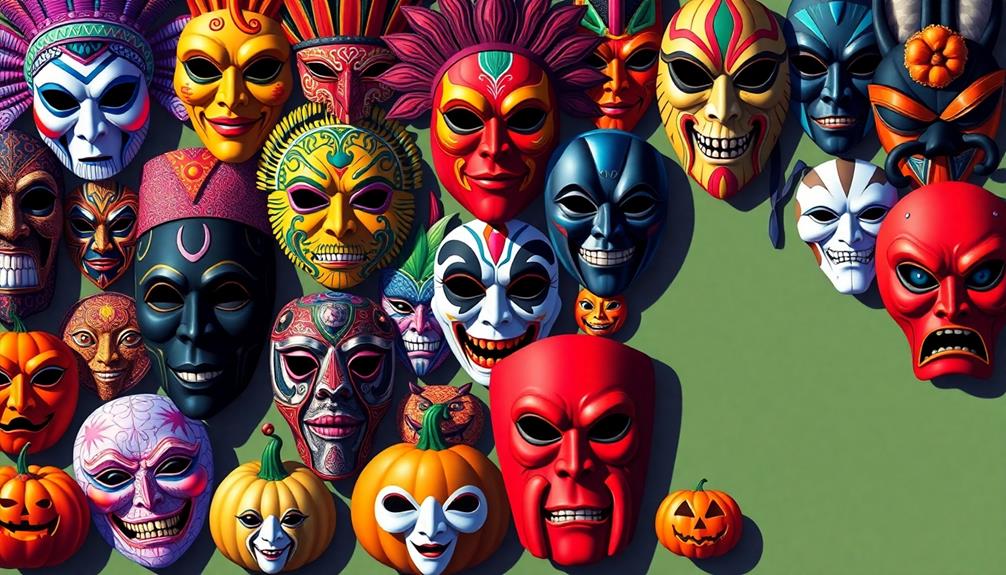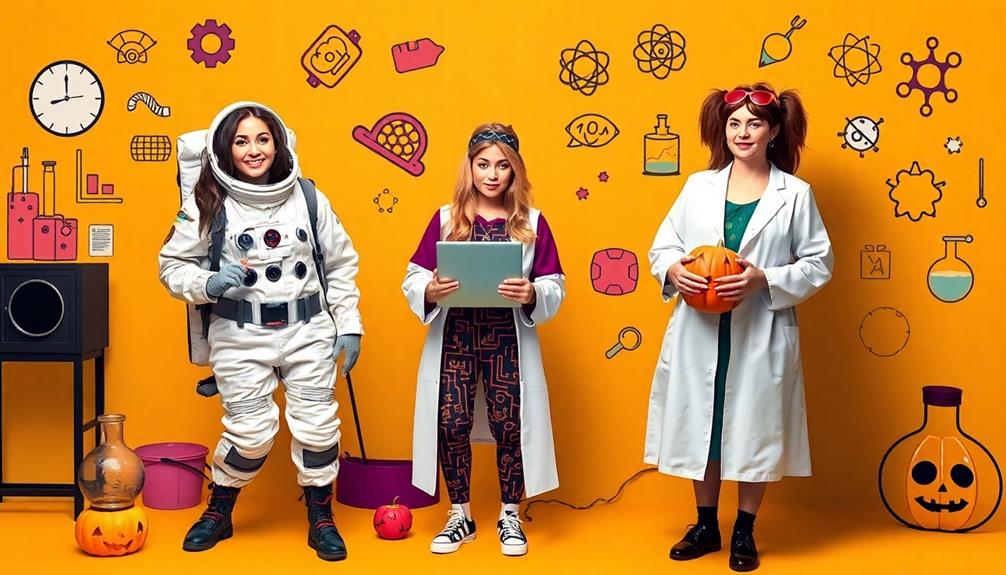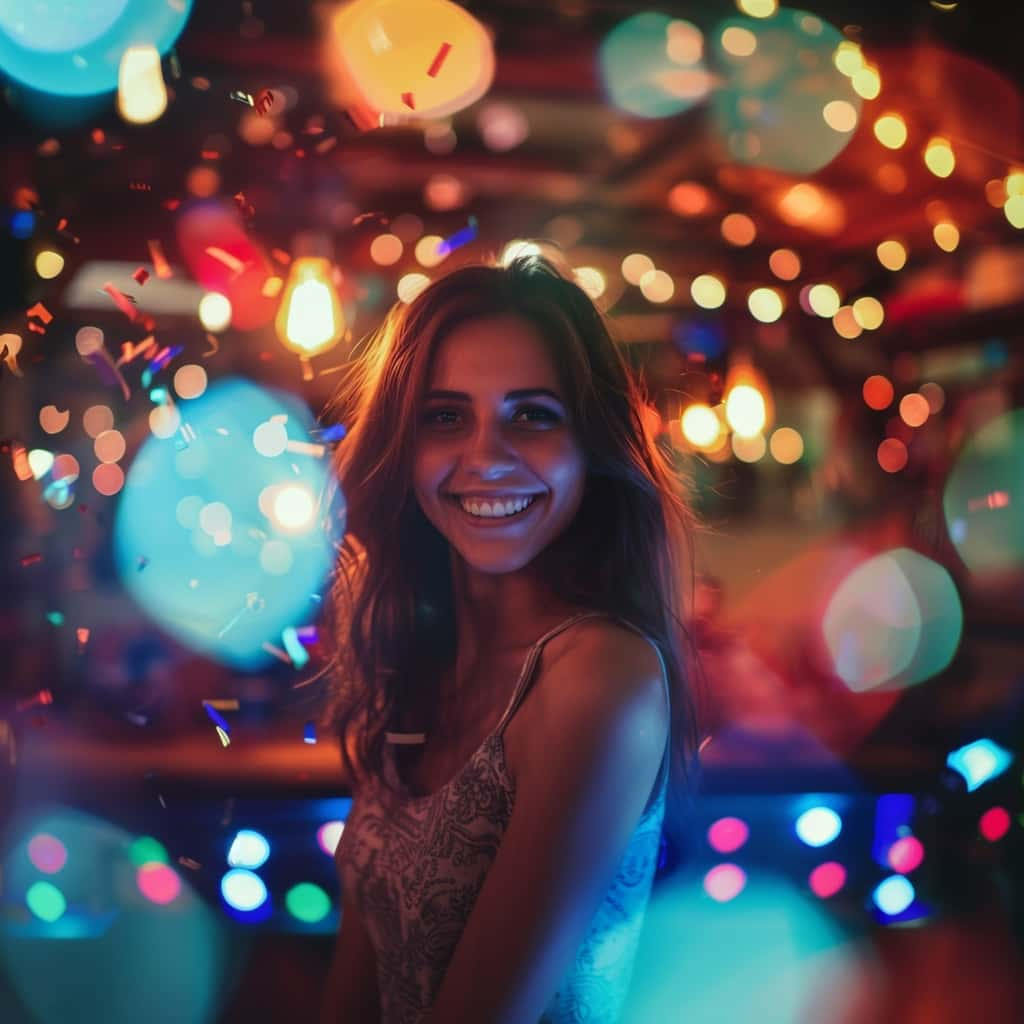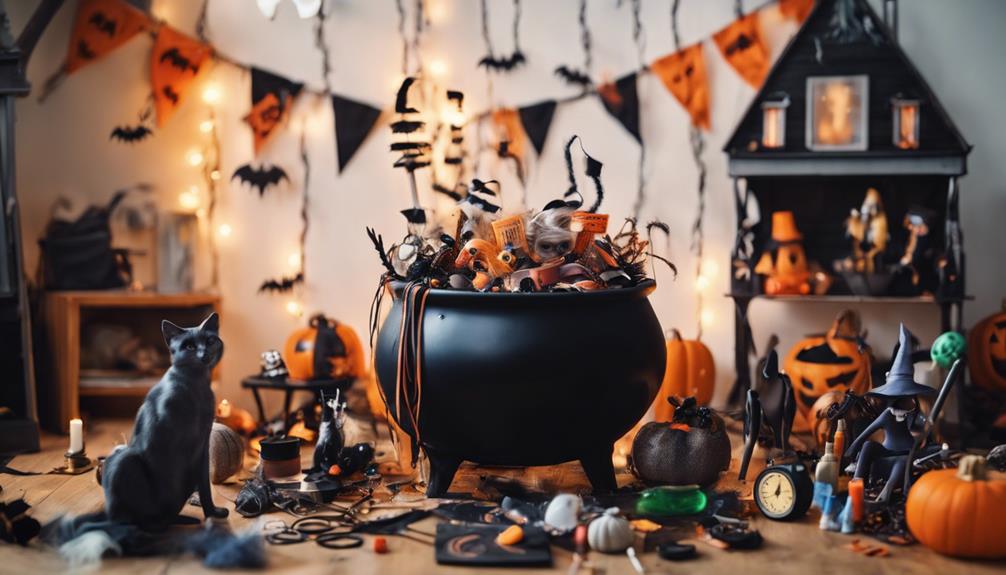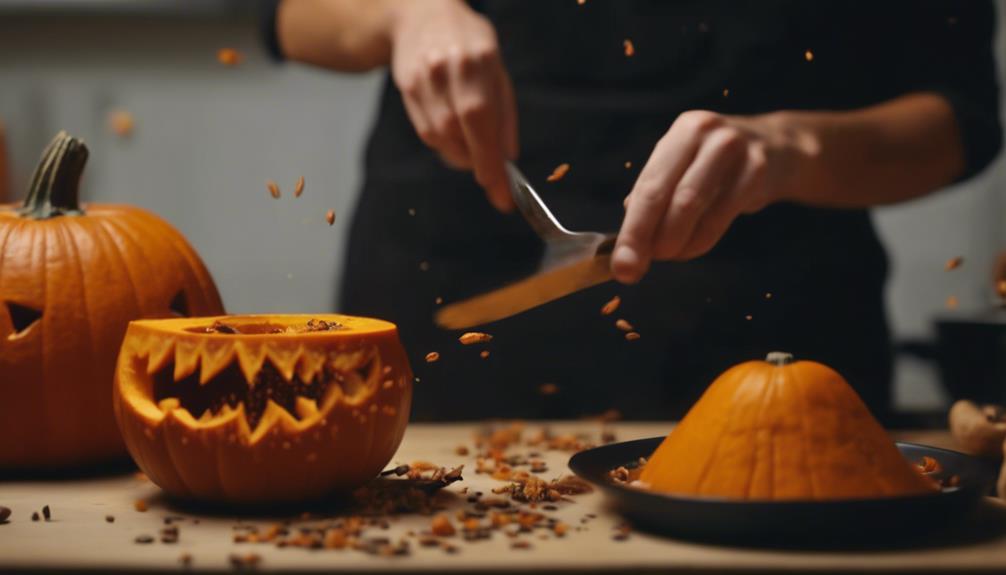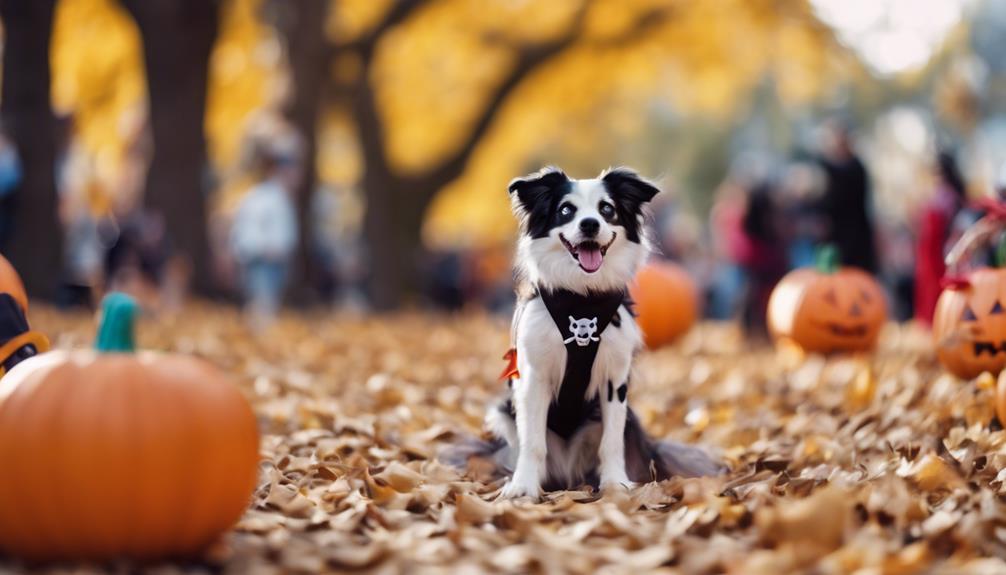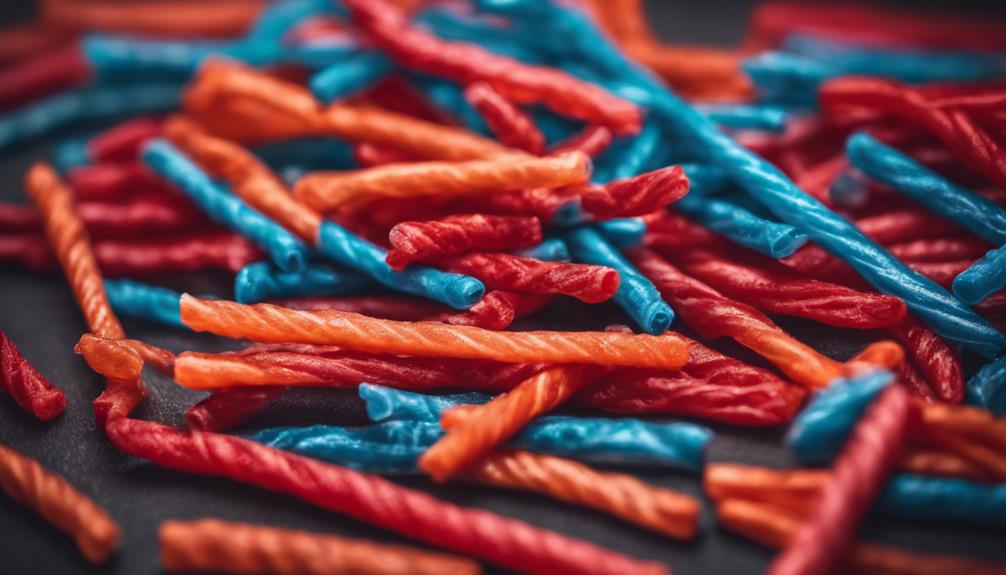Masks have shaped cultural rituals and celebrations across the globe, greatly influencing Halloween as we understand it. In ancient Celtic traditions, masks confused spirits during Samhain, while African and Japanese cultures use them to honor ancestors and convey emotions. The Renaissance introduced masquerade balls, promoting identity play that continues today. Modern Halloween masks blend fear and creativity, allowing you to explore various personas. This evolution reflects deep cultural significance and fosters connections among celebrants. If you're curious about how these traditions intertwine with contemporary practices, there's much more to uncover.
Key Takeaways
- Masks historically served protective purposes in Celtic Samhain, influencing modern Halloween customs through spirit confusion and embodiment practices.
- Various cultures use masks in rituals to communicate with ancestors, highlighting their spiritual significance and connection to the afterlife.
- The evolution of masks from ancient traditions to contemporary Halloween showcases creativity and the blending of cultural practices throughout history.
- Masks in cultural festivals, like the Venetian Carnival and Dia de los Muertos, celebrate identity and remembrance, enriching Halloween traditions with diverse influences.
- Performance arts utilize masks to enhance storytelling and emotional expression, a practice that has permeated Halloween celebrations through playful disguise.
Historical Origins of Masks
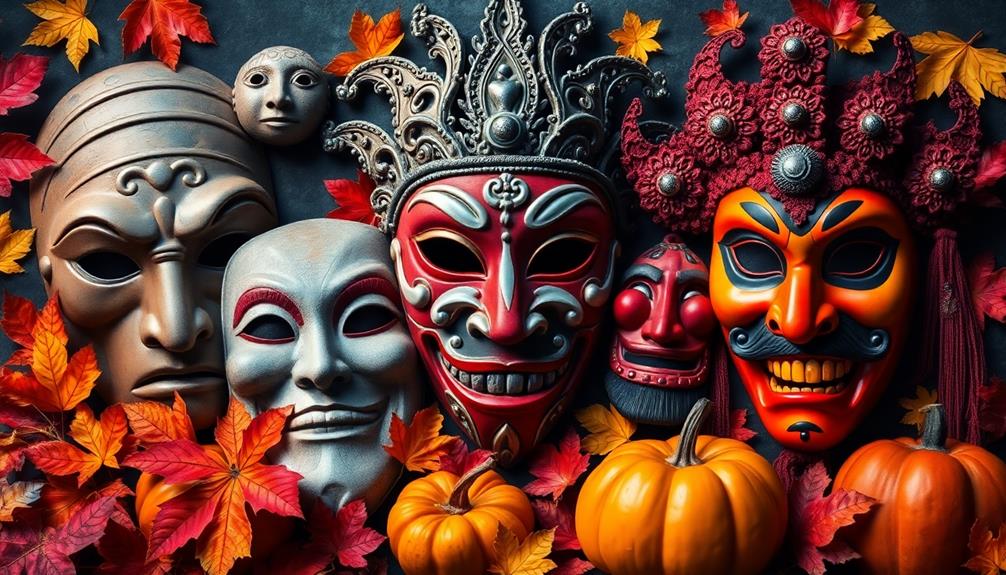
Have you ever wondered how masks became such an essential part of cultural expressions around the world? Their roots run deep, tracing back to ancient traditions. In Celtic culture, masks were worn during the Samhain festival to confuse spirits and protect against hauntings. This practice highlights the spiritual connection masks had in early societies.
In ancient Rome, masks shifted into the domain of performance art, enhancing theatrical plays and festivities. This influence paved the way for masquerade balls and carnival celebrations that we still enjoy today.
Similarly, in ancient Egypt, death masks played a critical role in recognizing a deceased's soul, helping guide them in the afterlife.
As cultures evolved, so did the significance of masks. The blending of pagan and Christian customs transformed Halloween celebrations, allowing participants to embody spirits and mythical creatures.
When Irish and Scottish immigrants brought these traditions to America, they further popularized mask-wearing, infusing modern festivities with a playful spirit.
Today, masks symbolize a rich tapestry of cultural history, connecting us to our ancient past while continuing to inspire creativity and expression.
Masks in Cultural Rituals
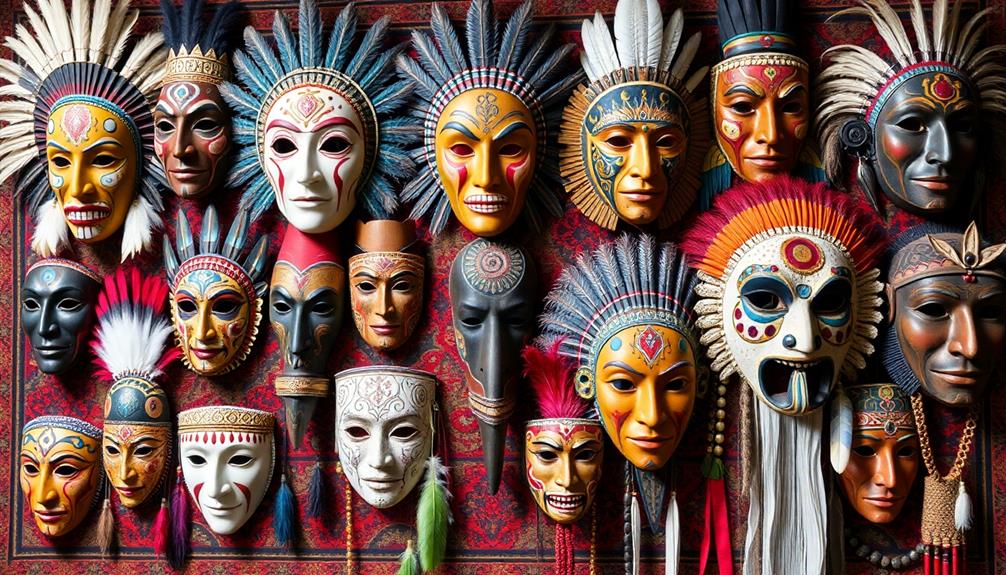
Celebrating cultural rituals with masks brings to life centuries of tradition and spiritual connection. Masks used in various ceremonies serve not just as decorative items but as powerful tools for communication with the spiritual domain.
For instance, in African tribal rituals, masks symbolize ancestors and deities, allowing you to channel spirits during ceremonies, facilitating a bridge between the living and the divine.
In the Tsimshian culture of northwestern Canada, masks representing chaotic spirits are employed by Gitsontk to maintain social order within their communities. These masks embody forces that are crucial for harmony, showcasing the integral role masks play in community cohesion.
Similarly, the ancient Egyptians utilized death masks to aid deceased souls in recognizing their bodies, allowing for a smooth passage to the afterlife.
Japanese Noh Theatre also highlights the cultural significance of masks, where they depict characters and convey deep emotions.
During the Celtic Samhain festival, early forms of masks were worn to confuse spirits, laying the groundwork for modern Halloween traditions.
Through these examples, it's clear that masks are essential in rituals, representing a profound connection to heritage, spirituality, and community.
Masks in Performance Arts
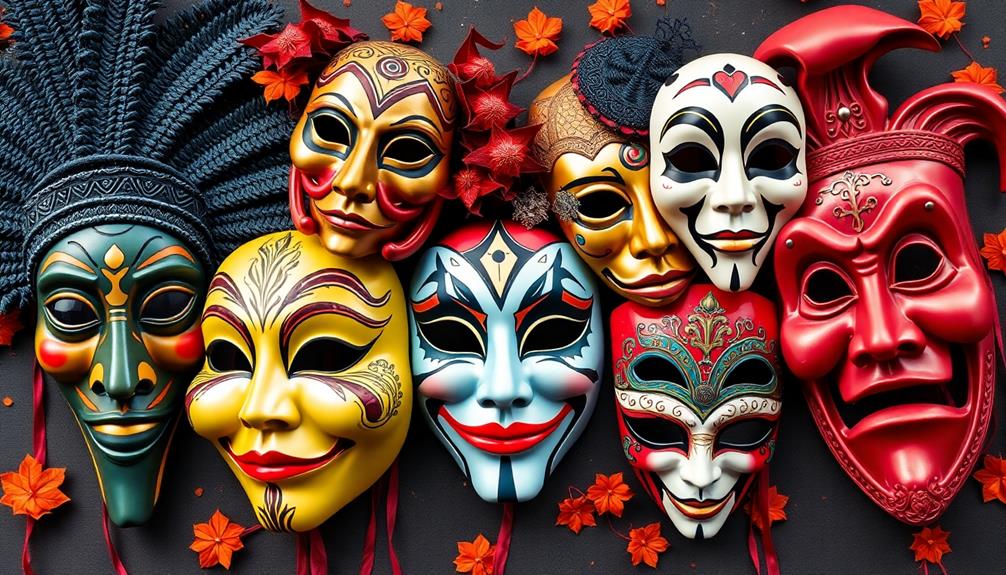
Masks play a vital role in performance arts, building on their significance in cultural rituals. They're primarily used to enhance storytelling, allowing performers to embody different characters and convey a wide range of emotions. From ancient Greek theaters to contemporary stages, masks have always served as a means of transformation, enabling artists to connect with their audience on a deeper level.
- Masks depicting exaggerated features engage viewers and heighten emotional impact.
- In Medieval mystery plays and Renaissance commedia dell'arte, masks allowed performers to channel various personas.
- Japanese Noh theater showcases intricately crafted masks representing specific emotions and character traits.
- African tribal rituals incorporate masks in dance performances, symbolizing ancestral spirits.
The use of masks in performance arts isn't merely a visual element; it enriches cultural expressions across societies. These powerful tools provide a unique opportunity for wearers to explore alternate identities, making the narratives more complex and engaging.
As you immerse yourself in performances that utilize masks, you'll appreciate how they not only enhance artistic expression but also connect you to the cultural heritage behind these age-old practices.
Masks in Festivals and Celebrations
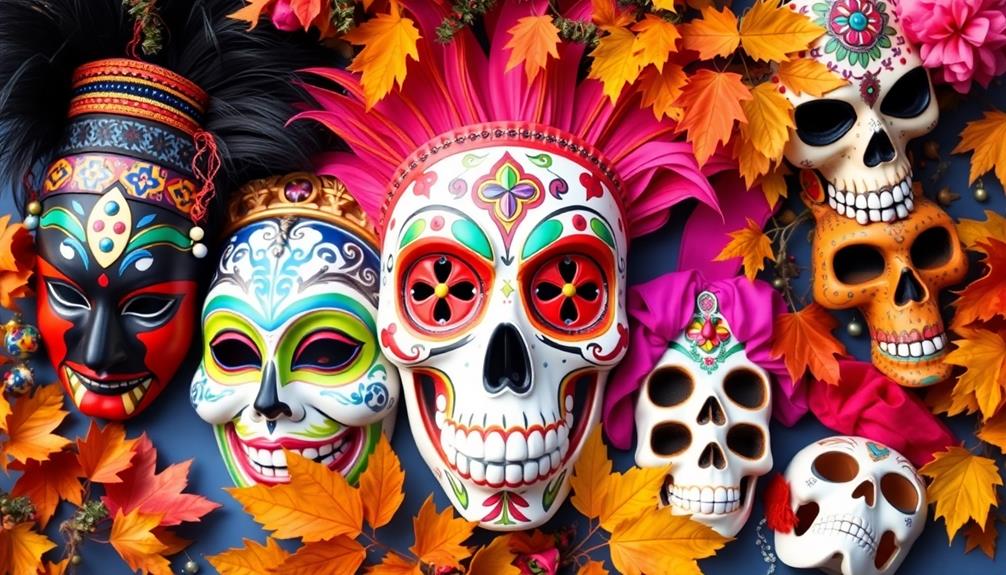
When you think about festivals and celebrations, masks often take center stage, adding a rich layer of meaning and tradition.
From the anonymity of the Venetian Carnival to the vibrant calacas of Dia de los Muertos, masks have evolved to reflect cultural significance and community identity.
As you explore these festivities, you'll see how masks not only enhance the experience but also connect us to our past.
Cultural Festival Significance
Throughout history, masks have served as essential elements in various cultural festivals, enriching the experience for participants and spectators alike. They create connections between the past and present, allowing you to engage deeply with cultural traditions. Masks are traditionally used in celebrations to embody different spirits, paying homage to ancestors, and enhancing storytelling.
Consider how masks feature prominently in:
- Venetian Carnival: They allow for anonymity, breaking social barriers through extravagant masks and costumes.
- Day of the Dead: Calacas, or skeleton masks, honor the deceased, celebrating the cycle of life and death in vibrant festivities.
- African Tribal Rituals: Masks symbolize ancestors and deities, reinforcing cultural identity and unity within the community.
- Japanese Noh Theatre: Masks convey complex emotions, enriching the narrative and artistic expression.
These cultural significances highlight how masks transform festivals into immersive experiences. In each tradition, masks and costumes become more than mere adornments; they embody the essence of celebration, connection, and remembrance, making them crucial to the richness of human culture.
Evolution of Celebration Masks
Celebrations around the world have seen masks transform considerably over the ages, adapting to the cultural contexts in which they're used. In ancient times, Celts wore animal heads during the Samhain festival to ward off spirits, laying the groundwork for how masks are used today.
Over time, masks evolved quite dramatically, leading to modern Halloween masks that blend elements of fear and fun. This evolution parallels the variety of Halloween costume ideas that draw inspiration from popular culture and literature, showcasing the creativity behind festive attire Halloween costume ideas.
The Venetian Carnival introduced elaborate masks that transcended social boundaries, influencing contemporary mask-wearing traditions during festive celebrations.
In Mexico, calacas play a crucial role during Dia de los Muertos, honoring deceased loved ones and showcasing the cultural significance of masks in commemorative festivals.
Similarly, Japanese Noh Theatre employs masks to portray characters and convey emotions, reflecting their longstanding artistic role.
African tribal rituals emphasize the global diversity of masks, often incorporating them to symbolize ancestors and deities.
This rich tapestry of traditions shows how masks have adapted and evolved within different cultures, enriching festivals and celebrations worldwide.
From honoring spirits to celebrating life, masks continue to serve as powerful symbols, connecting us to our history and each other during festive occasions.
Masks and Spiritual Beliefs
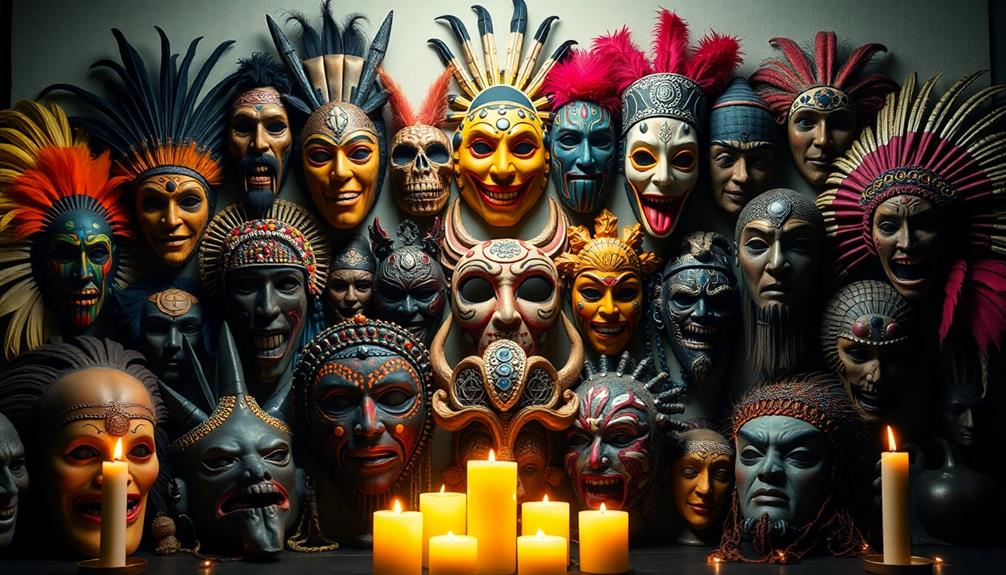
Masks play an essential role in various spiritual beliefs around the world, serving as powerful tools for connection and transformation. Through their use, you can see how different cultures engage with the spirit world and honor their ancestors.
For instance, ancient Neolithic masks facilitated ancestor worship, allowing the living to connect with the dead. In Celtic traditions, wearing masks during Samhain helped confuse and ward off spirits, highlighting the belief in the supernatural's impact on daily life. This practice resonates with the notion of recurring themes in global supernatural tales, where masks often symbolize a bridge between the domains of the living and the dead.
Here are a few key points about masks and spiritual beliefs:
- Communication with Ancestors: African cultures, like the Yoruba and Igbo, use masks in rituals to connect with their ancestors and deities.
- Cultural Identity: Masks embody spiritual beliefs while preserving the rich cultural identities of various communities.
- Integration of Traditions: The Roman Catholic Church's use of masks during All Hallows' Eve blends pagan customs with Christian beliefs.
- Modern Echoes: Today's Halloween masks reflect historical spiritual practices, allowing you to embody supernatural entities and explore themes of fear and the afterlife.
The Evolution of Halloween Masks
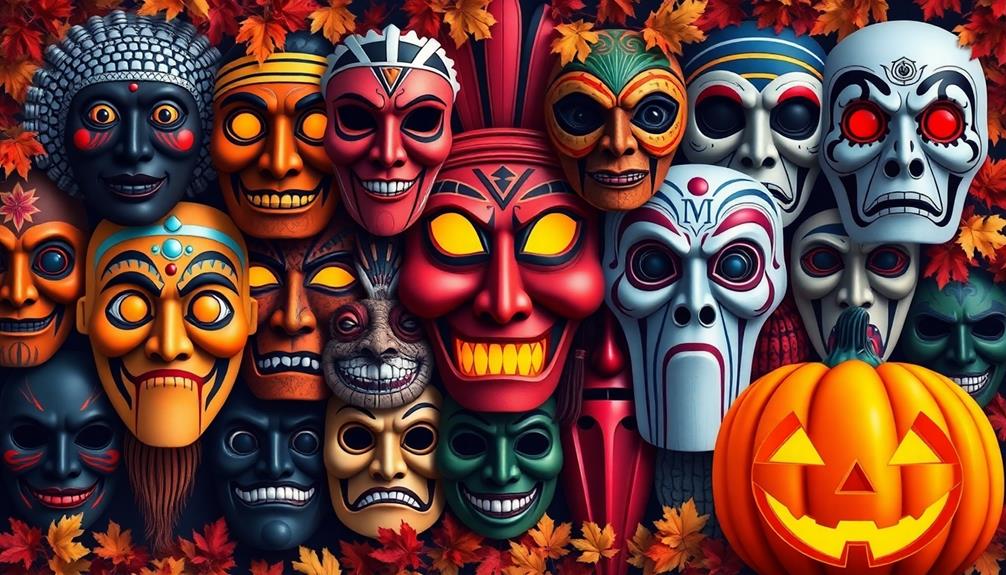
The transformation of Halloween masks reflects a rich tapestry of cultural influences and evolving traditions. Initially, during the ancient Celtic festival of Samhain, masks would serve a protective purpose, confusing and warding off spirits during seasonal changes.
As time progressed, the Renaissance introduced masquerade balls where face masks gained popularity for identity disguise, shaping modern Halloween practices. This evolution in mask use mirrors the significance of masks in various cultures, such as the intricate Indonesian decor masks that embody rich cultural heritage and artistry.
When Irish and Scottish immigrants arrived in America in the 19th century, they brought their Halloween customs along, further popularizing the use of masks for trick-or-treating and festive celebrations.
Over the years, these masks evolved from simple protective gear into vibrant expressions of creativity. Today, modern Halloween masks draw inspiration from pop culture, historic figures, and fictional characters, reflecting societal themes and individual expression.
This playful use of masks during Halloween signifies a shift in human nature—from merely safeguarding against spirits to embracing creative self-expression.
Now, you can embody different identities for entertainment and fun, transforming the night into a celebration of imagination. Each mask tells a story, allowing you to explore various facets of yourself, all while honoring a tradition that has spanned centuries.
Masks as Symbols of Identity
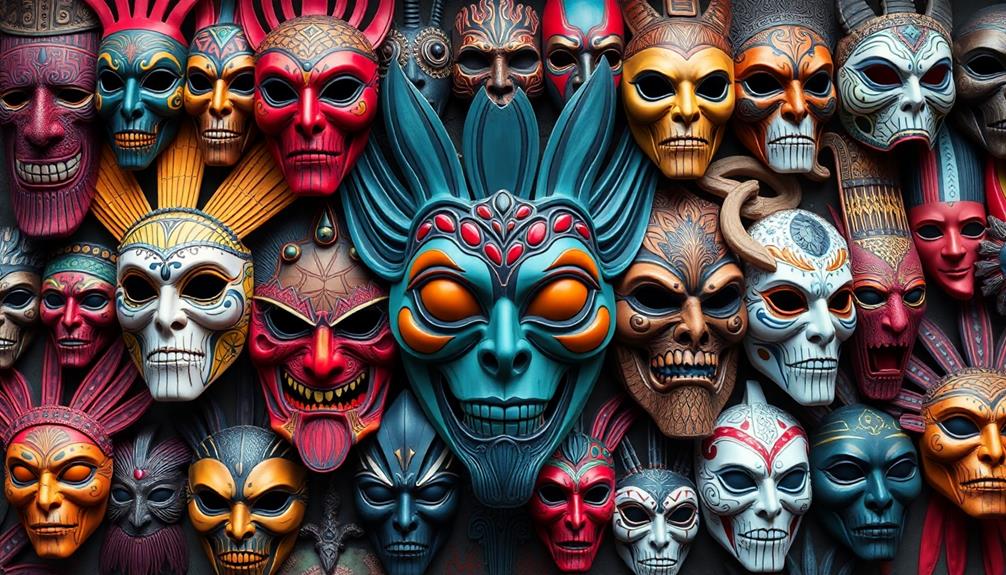
Masks can transform your identity, allowing you to express cultural nuances and explore different personas.
Whether you're blending into a crowd during a festival or embodying a character in a performance, masks facilitate a powerful connection between disguise and self-expression.
They invite you to navigate the complex interplay of individuality and collective identity, revealing layers of who you are.
Cultural Identity Expression
Throughout history, masks have served as powerful symbols of cultural identity, enabling individuals to convey their social roles, heritage, and beliefs. In various cultures, masks embody deep connections to ancestral spirits and community values, allowing wearers to express their identities during rituals and celebrations.
- Kanaga masks from the Dogon people in Mali represent ancestral spirits, linking the living to their heritage.
- Venetian Carnival masks allow wearers to transcend social boundaries, revealing hidden aspects of their identity without judgment.
- Calacas worn during Dia de los Muertos in Mexico honor deceased loved ones, celebrating cultural identity through remembrance.
- Noh theater masks in Japan illustrate complex character traits, allowing performers to embody historical figures and convey emotions.
These examples highlight how masks are more than mere decorations; they're essential tools for expressing cultural identity.
By donning a mask, you connect with your roots, honor your ancestors, and participate in a rich tapestry of tradition.
In a world that often seeks to categorize, masks offer a unique way to showcase the multifaceted nature of identity and heritage, fostering a deeper understanding of cultural diversity.
Disguise and Transformation
Disguises can reveal new dimensions of identity, allowing individuals to step into roles far removed from their everyday lives. Throughout history, masks have served as powerful tools for disguise and transformation.
In ancient Celtic traditions, for instance, wearing animal masks during Samhain helped ward off spirits, embodying different identities that connected the community to their beliefs. Similarly, in Indigenous cultures, masks play a significant role in ceremonial practices, representing connections to land and ancestry, which can be seen in the artistry of Aboriginal Art Dot.
During the Renaissance era, masquerade balls utilized masks to break down societal barriers, enabling you to interact anonymously and explore new personas without judgment. The Venetian Carnival exemplifies this concept, as masks foster anonymity and allow participants to transcend social boundaries, releasing creativity and self-expression.
In various African tribal ceremonies, masks represent ancestors or deities, facilitating a connection with heritage and spiritual identities.
Today, modern Halloween traditions continue this legacy, where masks reflect a blend of fear and fun. You can transform into anything from a monster to a superhero, using the playful disguise to escape reality for a moment.
Ultimately, masks symbolize the rich tapestry of human experience, inviting you to explore and embrace the many facets of identity that reside within you.
Cultural Variations in Mask Design
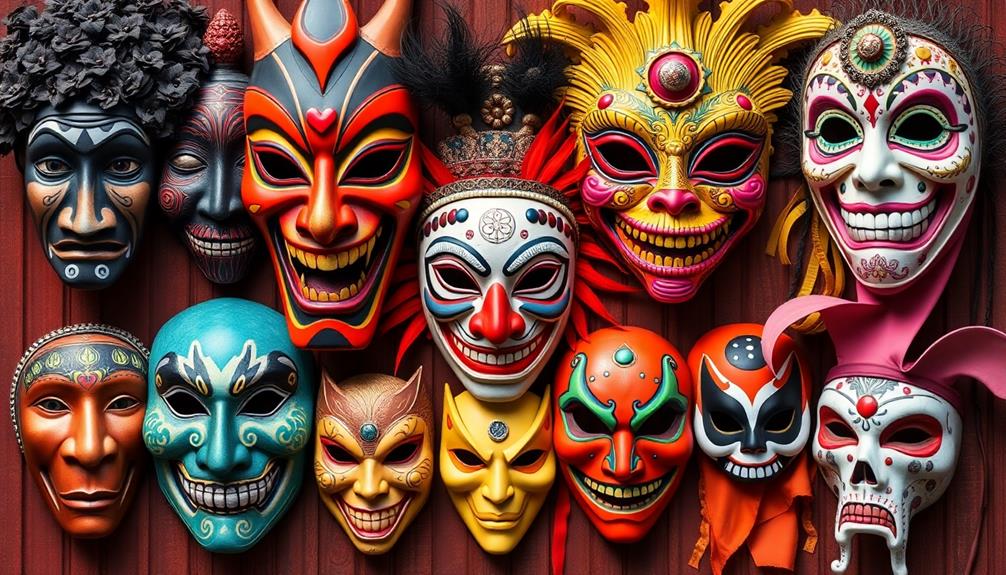
Diving into the world of cultural variations in mask design reveals a rich tapestry of artistic expression and meaning. Across different cultures, masks serve unique purposes and embody distinct artistic styles, reflecting the values and beliefs of the communities that create them.
- African Masks: Intricate carvings and vibrant colors symbolize ancestors and spiritual connections, especially among the Dogon people during masquerade rituals.
- Japanese Noh Masks: Crafted from wood and lacquered, these masks convey a range of emotions, allowing actors to embody complex characters in traditional theater.
- Venetian Carnival Masks: Known for elaborate designs featuring feathers and gold leaf, they allow wearers to transcend social boundaries and maintain anonymity during festivities.
- Mexican Day of the Dead Masks: Brightly painted with symbols like flowers and skulls, these masks celebrate deceased loved ones while reflecting cultural beliefs about death.
Masks are also used to transform the human face into something symbolic or narrative-driven.
These cultural variations not only showcase diverse artistry but also highlight the profound meanings behind each design, making masks an essential part of cultural heritage and expression.
Psychological Effects of Mask-Wearing

When you put on a mask, you might feel a shift in your identity, as it offers a chance to explore different parts of yourself without the usual constraints.
This anonymity can reduce your fear of judgment, encouraging bolder interactions in social situations.
As you engage with others while masked, you may discover a newfound sense of freedom and connection.
Identity Transformation Effects
Masks open up a world of possibilities for identity transformation, allowing you to explore parts of yourself that might usually stay hidden. When you wear a mask, you shed your usual identity, experiencing a sense of freedom and creativity. This transformation can enhance your social interactions, leading to deeper connections and playful exchanges.
Here are some effects of wearing masks that contribute to identity transformation:
- Increased Boldness: Masks can reduce self-awareness, encouraging you to take risks and engage more boldly in social settings.
- Creative Expression: With societal norms less constraining, you feel liberated to express yourself in unique ways.
- Enhanced Social Bonding: Wearing masks fosters connections, as they create a shared experience that encourages interaction among participants.
- Deindividuation: The feeling of anonymity can lead you to explore hidden aspects of your personality, enriching your social experiences.
As you embrace these identity transformations, masks become powerful tools for self-discovery and social engagement, especially during festive occasions like Halloween.
Fear and Anonymity
One significant psychological effect of wearing masks is the sense of anonymity it provides, which can liberate you from the constraints of your everyday identity. When you don a mask, you might notice a shift in your behavior; the fear of judgment often fades away. This anonymity encourages self-expression, allowing you to explore different facets of your personality without the usual inhibitions.
In social settings, masks can promote a sense of deindividuation, where you lose self-awareness and embrace a more uninhibited version of yourself. This newfound freedom can lead to increased boldness and a willingness to engage in playful or daring activities that you might typically shy away from.
Moreover, masks create an atmosphere of intrigue and mystery, fostering connections between individuals by concealing identifiable features. In group dynamics, this equalization enhances social engagement, making interactions feel more comfortable and less judgmental.
During celebrations like Halloween, the act of wearing a mask becomes a vehicle for creativity and shared experiences, encouraging you to embody various personas.
Ultimately, masks empower you to transcend fear and embrace a more authentic form of self-expression, enriching social interactions in the process.
Modern Interpretations of Masks
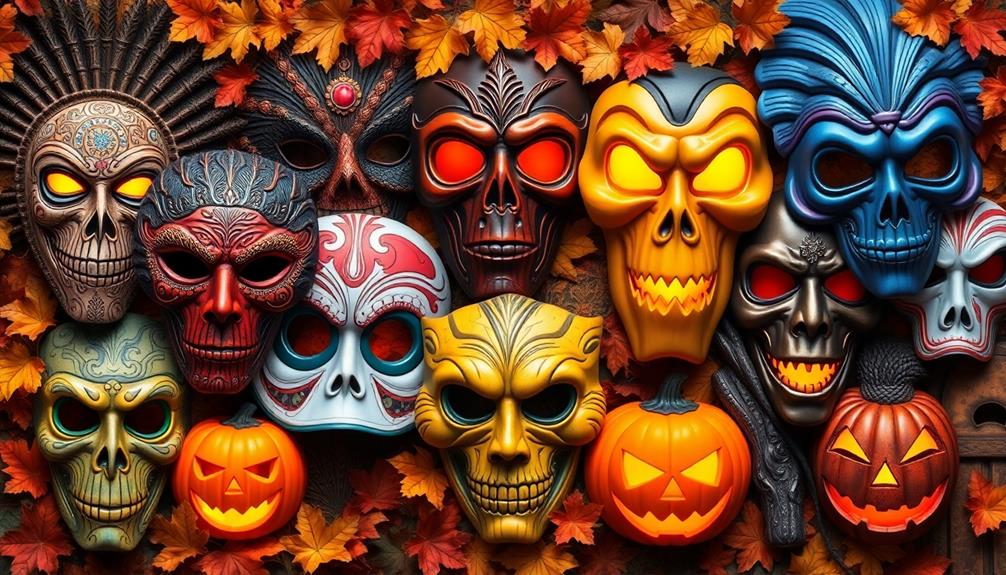
Throughout modern culture, masks have transformed into vibrant symbols of creativity and self-expression, especially during Halloween. Drawing from historical practices rooted in the Celtic Samhain festival, where Celts donned animal heads and skins to evade spirits, today's masks embody a playful spirit.
You'll find that modern interpretations allow you to become anything from classic horror figures to beloved pop culture icons.
Consider the following aspects of masks during Halloween:
- They encourage social interaction and playful banter among participants.
- Influences from global traditions, like Día de los Muertos, blend reverence with festivity.
- Iconic masks from films, such as Michael Myers or the Phantom, shape costume trends.
- They enable individuals to express their identity creatively through costume choices.
This evolution of masks highlights the diverse cultures that inform our celebrations.
Halloween has become a canvas for you to explore your creativity and connect with others, making masks an integral part of the festive experience.
Embrace the opportunity to express yourself while honoring the rich history behind these enchanting artifacts.
Frequently Asked Questions
What Is the Role of Masks in Different Cultures?
Masks in different cultures serve various roles, from embodying spirits to facilitating rituals. They connect you to heritage, express emotions, and protect during ceremonies, illustrating their significance in celebrating life, death, and communal identity.
What Does the Mask Represent in Halloween?
In Halloween, masks represent transformation and anonymity. When you wear one, you're not just hiding your face; you're embodying different identities, allowing you to explore various characters and challenge societal norms during the festivities.
What Are the Cultural Uses of Masks?
Masks serve various cultural purposes, from facilitating rituals and honoring ancestors to enhancing performances and allowing anonymity. You'll find them in celebrations and ceremonies, each carrying deep significance and connecting people across generations and traditions.
What Is the History of Halloween Costumes Masks and Traditions?
Halloween costumes and masks trace back to ancient Celtic traditions, where you'd scare away spirits. Over centuries, they evolved through cultural influences, becoming vibrant symbols of fun and creativity, reflecting your personal expression on this spooky night.
Conclusion
In exploring the fascinating world of masks, you've uncovered their rich tapestry woven through history, culture, and identity. From ancient rituals to vibrant celebrations, masks have always played a role in human expression and connection. As Halloween approaches, remember that these artful disguises allow you to step into another persona, embracing the playful spirit of transformation. So, don't just wear a mask—celebrate the myriad stories and traditions it represents, inviting a touch of mystery into your festive experience.
